Is Intel’s stock price surge a turning point or a temporary boost?
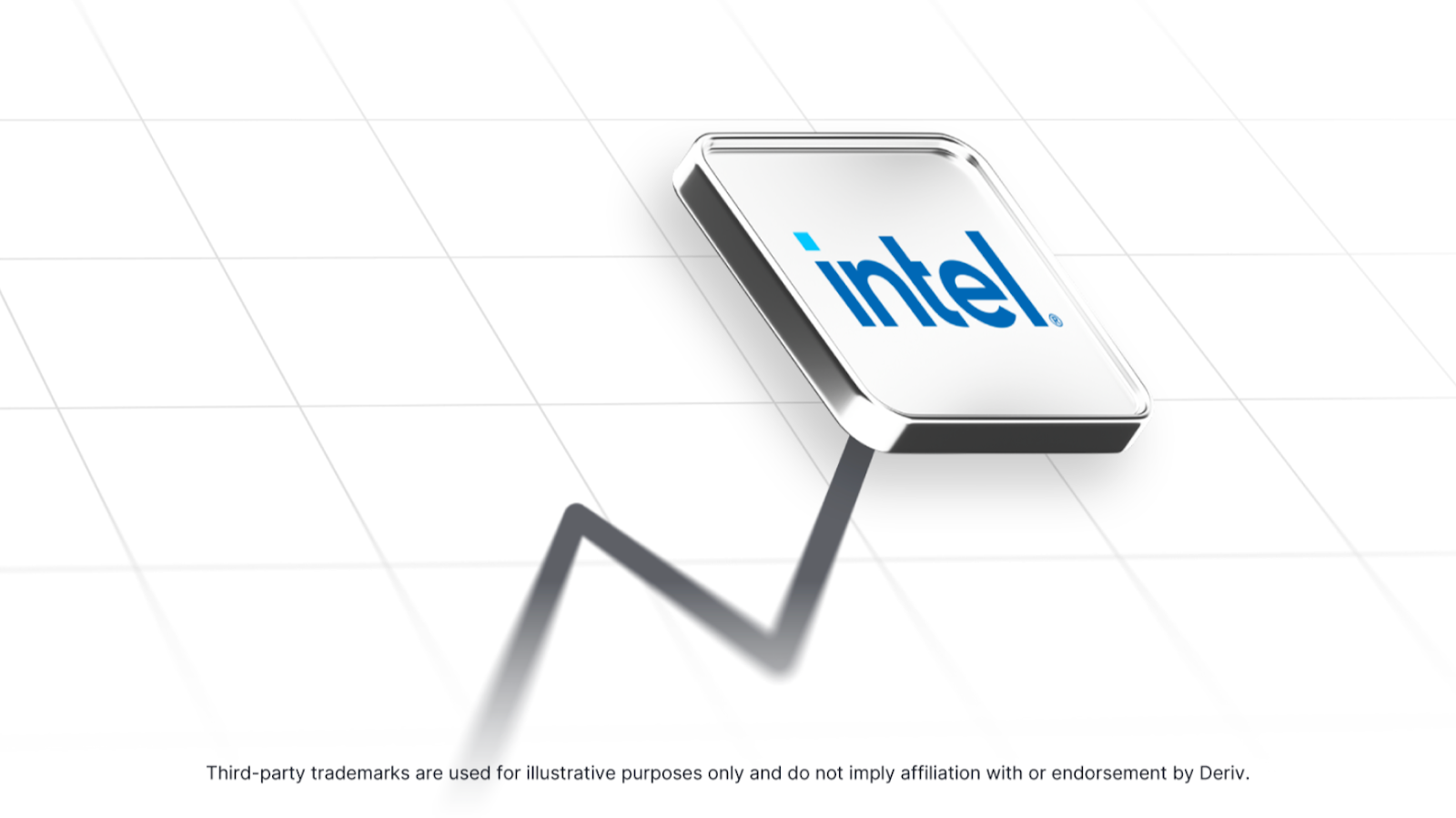
Intel shares surged following reports that the Trump administration may invest directly in the chipmaker. The rally came even as the broader PHLX Semiconductor Index fell more than 2%, highlighting Intel’s unusual strength in a weak sector. While the surge lifted Intel’s year-to-date gain to 19%, unusual trading activity before the announcement has fuelled insider speculation, raising questions about whether the move is sustainable or short-lived.
Key takeaways
- Intel shares rose 8.9% to $24.20 on reports of potential U.S. government investment, bucking a semiconductor sector decline.
- President Trump signalled tariffs of 200%–300% on imported chips, boosting hopes of domestic industry support.
- Intel CEO Lip-Bu Tan met Trump days before the rally, though Trump had previously criticised him over alleged China ties.
- Unusual call option activity before the announcement raised suspicions of insider trading.
- Analysts see government support as a potential “lifeline” for Intel, but retail investors question market fairness.
- Intel’s Ohio fab project and 14A process development are central to government stakeholder discussions.
Intel’s rallies strongly amid sector weakness
Intel’s surge was notable because most chip stocks were under pressure after Trump threatened steep new tariffs on imported semiconductors, promising rates of 200%–300% “next week or the week after.”
The comments rattled the sector, sending the PHLX Semiconductor Index down more than 2%. Intel, however, was among the few to rise - a reaction tied to reports that the U.S. government is considering taking a direct equity stake in the firm.
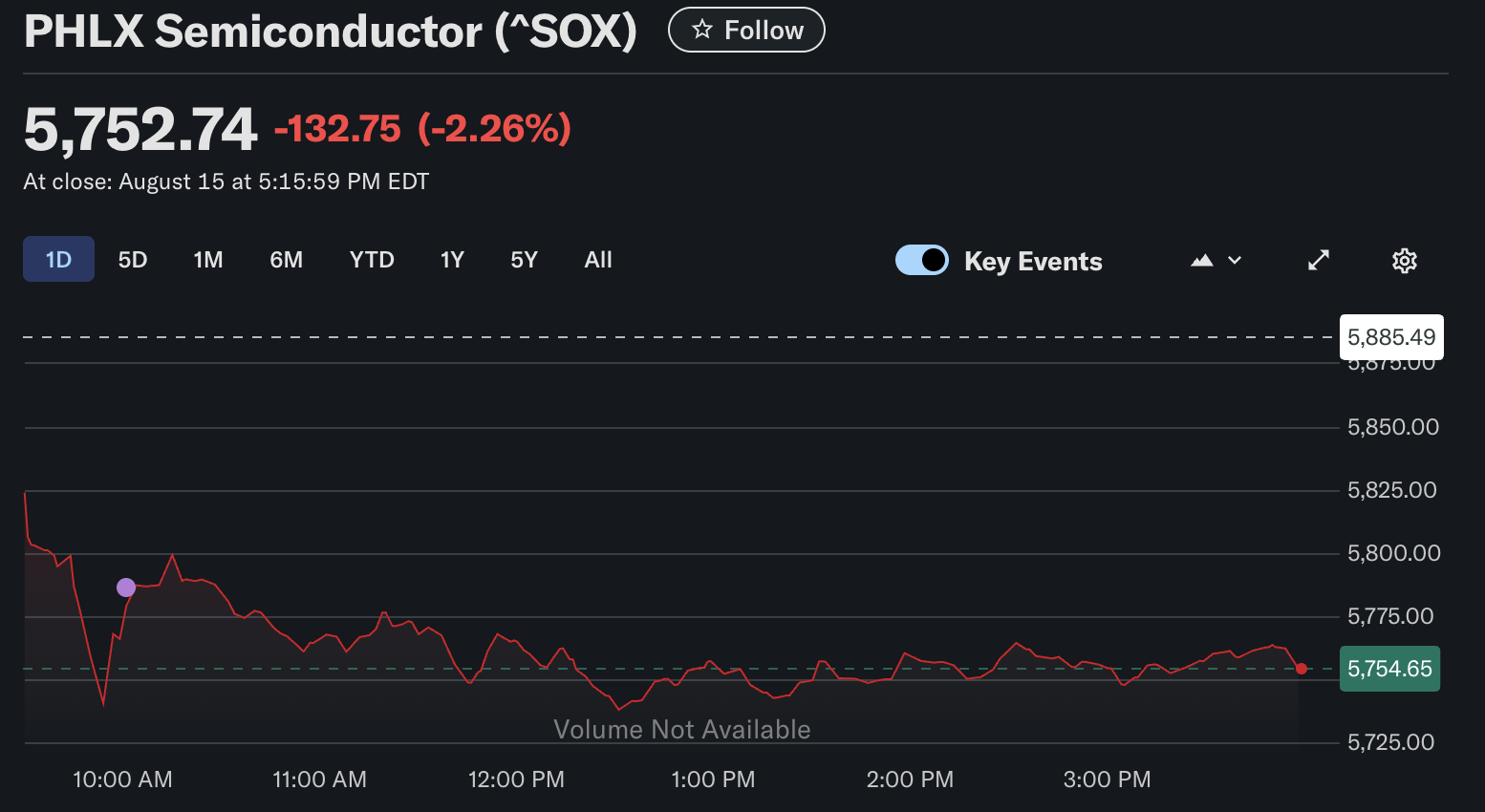
The potential investment could be partially funded by the CHIPS Act, despite Trump’s earlier criticism of the programme. Talks reportedly accelerated after Intel CEO Lip-Bu Tan met with Trump on 11 August. The meeting was controversial: just days earlier, Trump had publicly called for Tan’s resignation, citing alleged ties to China.
Intel’s rally was preceded by some suspicious trading
Intel’s rally was preceded by unusual call option activity. Significant volumes traded in the days before the government stake reports surfaced, with prices favouring sellers who likely made millions.
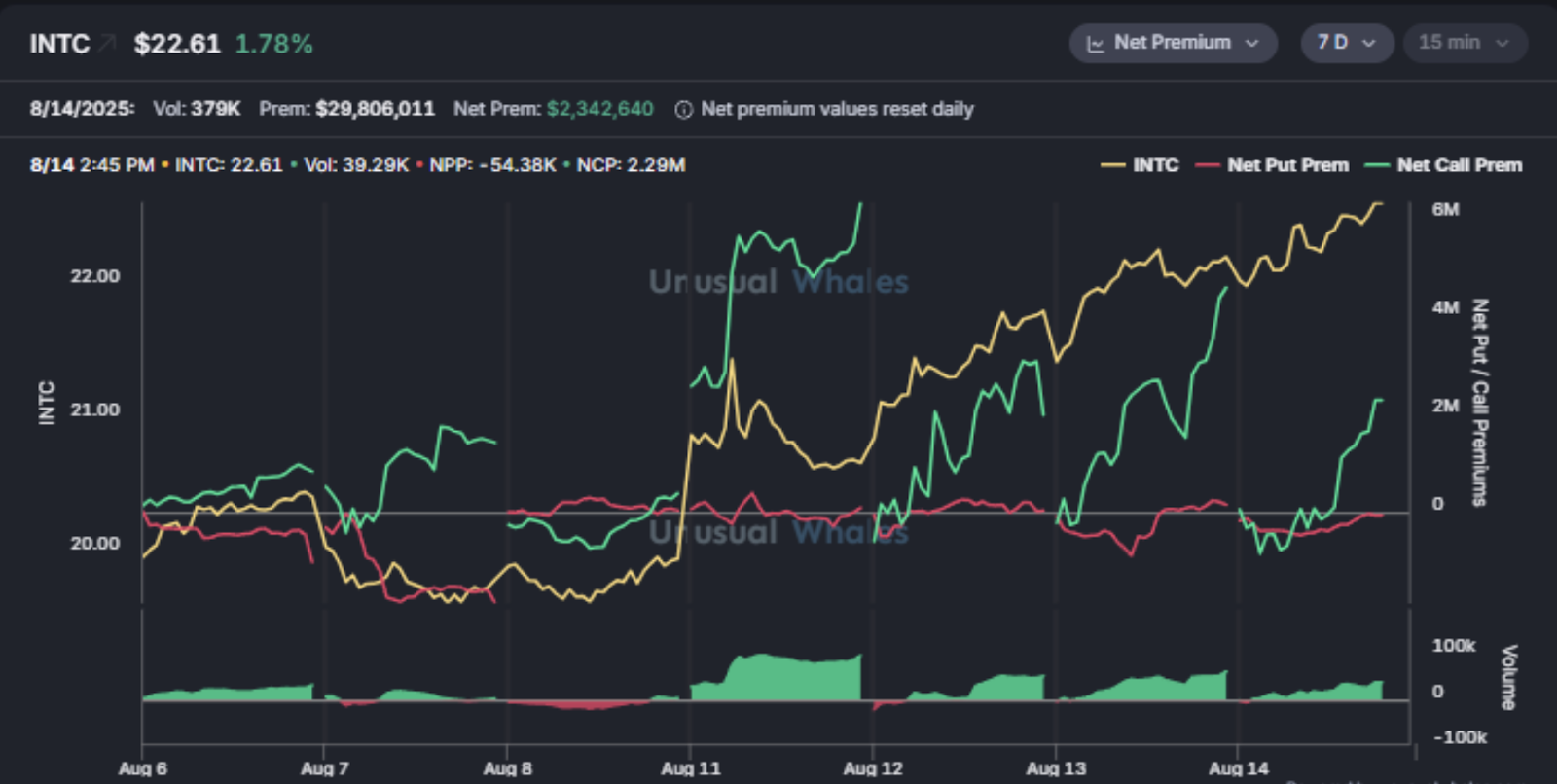
This has fuelled speculation that some investors had advance knowledge of the announcement. Research published in the Journal of Financial Economics in 2021 found that abnormal option trading volumes increase by up to 50% in the one to three days before major corporate news. Intel’s case fits this pattern closely.
Yet, despite these signals, enforcement remains inconsistent. A 2023 ScienceDirect study found the SEC only pursues around 60% of identified insider trading cases, leaving a gap that undermines retail investor confidence. For many, Intel’s spike reinforces the perception that the market rewards insiders while leaving ordinary traders reacting after the fact.
Government stake in chipmakers as a strategic shift
Analysts say a direct government stake could provide Intel with critical support. Bernstein’s Stacy Rasgon noted that U.S. backing could help fund Intel’s 14A process - a next-generation chip architecture aimed at narrowing the gap with rivals Nvidia and TSMC. It would also provide capital to sustain costly fab construction, particularly Intel’s $20 billion Ohio project, which has faced repeated delays.
But questions remain about what the government might want in return. In recent months, the administration has forced Nvidia and AMD into revenue-sharing agreements, requiring both companies to hand over 15% of Chinese revenues in exchange for export licences on AI chips. Similar arrangements could be sought from Intel in exchange for support.
Intel’s US chip manufacturing struggles
Intel’s market value has fallen by more than half since 2020, down to $107 billion.
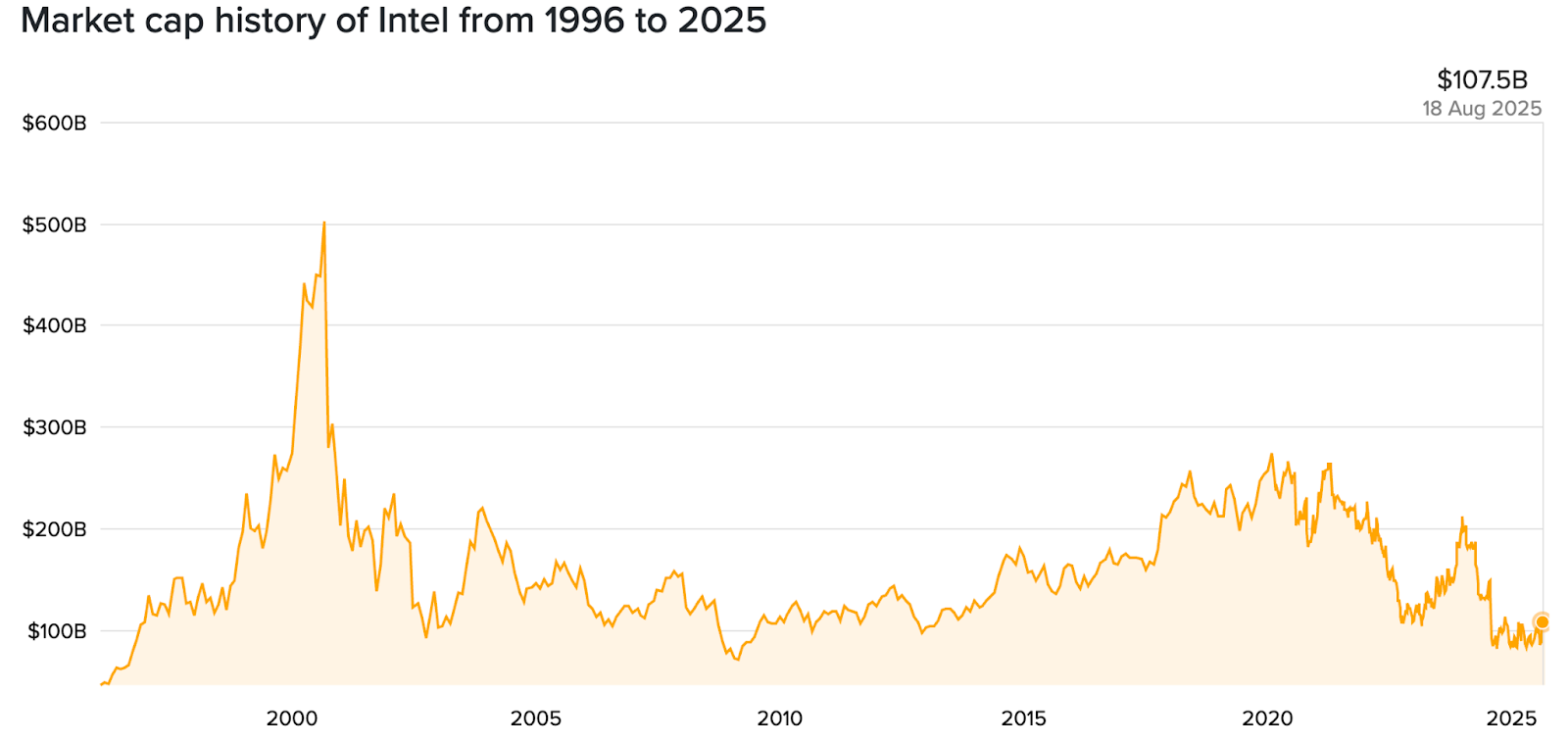
Intel has lost ground in the AI race, with Nvidia seizing leadership in high-performance GPUs and AI accelerators. It has also faced cancelled factory projects in Germany and Poland, and delays to its flagship Ohio fab have hampered U.S. efforts to build domestic chipmaking capacity.
Former CEO Pat Gelsinger had begun an ambitious push to expand Intel’s global manufacturing footprint but stepped down in December 2024 after cash burn and repeated setbacks. Lip-Bu Tan, who took over in March 2025, has emphasised financial discipline and a renewed focus on catching up in AI.
Some analysts, including Jim Cramer and Morningstar’s Brian Colello, argue that Intel “needs the help.” Cramer noted a government stake could complete projects that Gelsinger started but could not afford to finish.
Toward U.S. state capitalism?
The reported move would represent a break with the U.S.’s traditional laissez-faire approach. Recent actions suggest a shift toward state capitalism, with Washington intervening directly in strategic industries:
- The Department of Defense bought $400 million in preferred shares of MP Materials, a rare earths miner.
- A “golden share” was taken to allow Nippon Steel’s acquisition of U.S. Steel.
Globally, this mirrors models in Asia. Taiwan’s sovereign wealth fund holds 6.4% of TSMC, providing a precedent for governments directly supporting chipmakers.

Analysts such as David Nicholson of Futurum Group say Intel could be a “special case,” strategically vital to U.S. competitiveness in semiconductors and national security.
Market implications for investors
Intel’s sharp rise highlights optimism around a potential government-backed rescue. But the company’s underlying challenges - delayed projects, shrinking market share, and heavy cash burn - remain unresolved.
For retail traders, the episode underscores both opportunity and risk. If government support is confirmed, Intel could stabilise its finances and invest in catching up technologically. If talks stall or fail, the rally could fade quickly, leaving late buyers exposed.
Intel stock technical analysis
At the time of writing, the stock price is seeing some retreat after a sharp rally and is in price discovery mode. Despite the retreat, volume bars show a sharp spike in buy pressure - hinting at a further price uptick. Should we see a further uptick, prices could surge towards the $26.00 mark. Conversely, if sellers pile on the pressure, we could see prices held at the $19.74 and $19.38 support levels.
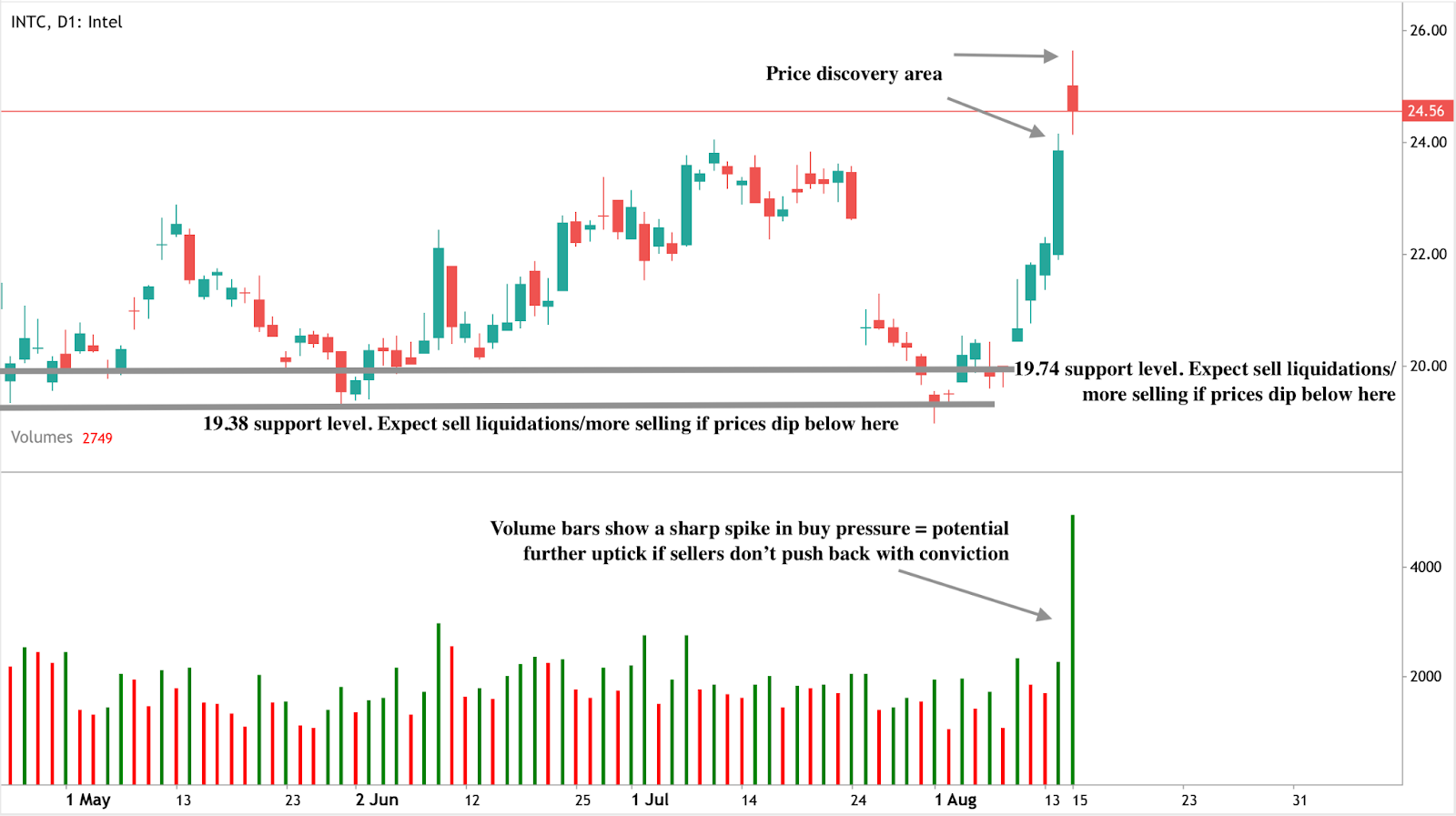
Investment implications
- Short term: Intel’s stock could remain volatile as headlines around tariffs and stake talks continue. Traders should watch for signs of confirmation from Washington.
- Medium term: If government support materialises, Intel could stabilise its balance sheet and fund its 14A chip development. Without it, cash burn and fab delays may pressure shares.
- For retail investors: The Intel case underscores the importance of monitoring not just headlines but also unusual trading flows that can signal insider activity.
Frequently asked questions
Why did Intel stock surge in August 2025?
This is because of reports that the Trump administration may take a direct stake in Intel and Trump’s announcement of possible 200%–300% tariffs on imported chips.
What raised speculation of insider trading?
A surge in call option trading volumes was detected before the government stake news, consistent with historical insider trading patterns.
What does the government want from Intel in return?
Analysts suggest possible revenue-sharing arrangements or strategic guarantees, similar to deals imposed on Nvidia and AMD.
Why is Intel’s Ohio project central to this?
The $20 billion facility is critical to U.S. chipmaking ambitions, but delays and funding shortfalls have slowed progress.
Is this common in the U.S. market?
No. Direct equity stakes by the U.S. government in private companies are rare, but have recently increased in strategic sectors like steel and rare earths.
Disclaimer:
The performance figures quoted are not a guarantee of future performance.



